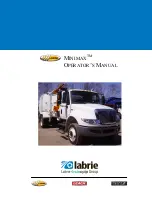
C A B A N D B O D Y M O U N T IN G S 1-60
This is due to the fact that the cover is not as hot
as the steam. The cover, therefore, takes heat
from the steam, condensing it back to water.
6. The temperature at which substances will
boil or condense is affected by pressure. Refer to
"Pressure Temperature Chart" (fig. 5). If the
pressure is increased, the liquid will not boil until
a higher temperature is reached. Thus, we can
prevent refrigerant from boiling if it is kept under
high pressure. If this high pressure is suddenly
released, refrigerant will immediately boil. This
has been demonstrated on modern vehicles with
pressure cooling systems.
When the pressure of a vapor is increased,
the temperature at which it will condense is also
raised. Steam condenses below 212^F., if heat is
removed from it, but it can be made to condense
at higher temperature by increasing the pressure.
7. Compressing a vapor increases its temp
erature. For example, when pumping air into a
tire with hand pump, the pump will become warm
due to the heating of the air as it is compressed.
8. When a liquid is heated until it is converted
to a gas, then this gas is heated additionally with
out changing pressure, the gas is said to be super
heated. For instance, in the evaporator refrigerant
absorbs heat and boils at a constant temperature
and pressure until it has been completely vapor
ized, and it continues to absorb heat from the warm
air passing over the evaporator without any in
crease in pressure. Since this heat is no longer
being used to convert the refrigerant from a liquid
to a gas, it will now cause the temperature of the
refrigerant to rise. The refrigerant is then super
heated.
REFRIGERANT
The refrigerants used are commonly known
by their trade name of Freon-12, Ucon-12, or Gene-
tron-12. Regardless of brand, refrigerant-12 must
be used. The chemical name of refrigerant-12 is
dichlorodifluoromethane (C C L
2
F
2
).
R E F R IG E R A N T C H A R A C T E R IS T IC S
Refrigerant exists as a gas at atmospheric
pressure and must be held under pressure to re
main liquid. At ordinary temperatures, it will exist
as a liquid under a pressure of about 75 pounds
per square inch.
Refrigerant has very little odor, but in large
concentrations a distinct odor may be detected. It
is colorless in both its liquid and gaseous states.
Refrigerant is nonpoisonous, nonflammable,
and nonexplosive. It is noncorrosive to any of the
ordinary metals.
Goggles should be worn whenever there is the
slightest possibility of refrigerant coming in con
tact with the face or eyes, because refrigerant
evaporates and cools so rapidly it will cause an
injury similar to frostbite.
P R O C U R E M E N T
Refrigerant is generally shipped and stored
in 25-lb. drums and 15-oz. cans.
It will be impossible to draw all the refriger
ant out of the drum. The use of warm water when
charging the system will assure the extraction of
a maximum amount of refrigerant from the drum.
Be sure to follow the instructions under "Charging
The System" explained later.
N O T E : Approximately 3-1/4 pounds of refrig
erant is required in system.
P R E C A U T IO N S IN H A N D L IN G R E F R IG E R A N T
1. Do not leave container of refrigerant un
capped.
2. Do not subject container to high temper
ature.
3. Do not weld or steam clean on or near
system.
4. Do not fill drum (when used) completely.
5. Do not discharge vapor into area where
flame is exposed,
6. Do not expose eyes to liquid.
All refrigerant drums are shipped with a
heavy metal screw cap. The purpose of the cap is
to protect the valve and safety plug from damage.
It is good practice to replace the cap after each
use of the dram for the same reason. If the drum
is exposed to the radiant heat from the sun, the
resultant increase in pressure may cause the
salety plug to release or the drum to burst.
For the same reason, the refrigerant container
should never be subjected to excessive temper
ature when charging a system. The refrigerant
drum (when used) should be heated for charging
purposes by placing in 125 F ., water. Never heat
above 125°F ,, or use blowtorch, radiator, or stove
to heat the drum.
Welding or steam cleaning on or near any of
the refrigerant lines or components of the air con
ditioning system could build up dangerous and
damaging pressures in the system.
If a small drum is ever filled from a large
one, never fill the drum completely. Space should
always be allowed above the liquid for expansion.
Weighing drums before and during the transfer
will determine fullness of drums.
Discharging large quantities of refrigerant
into a room can usually be done safely as the vapor
would produce no ill effects. However, this should
not be done if the area contains a. flame-producing
device such as a gas heater. While refrigerant
normally is nonpoisonous, heavy concentrations
of it in contact with a live flame will produce a
CHEVROLET SERIES 70 -80 H EAVY DUTY TRUCK SH O P M A N U A L
Summary of Contents for 70 1969 Series
Page 1: ...CHEVROLET HEAVY DUTY TRUCK SHOP MANUAL...
Page 3: ......
Page 11: ...LUBRICATION 0 4 CHEVROLET SERIES 70 80 HEAVY DUTY TRUCK SHOP MANUAL...
Page 27: ......
Page 119: ......
Page 361: ......
Page 371: ......
Page 427: ......
Page 443: ......
Page 451: ......
Page 493: ......
Page 499: ......
Page 549: ......
Page 555: ......
Page 609: ......
Page 715: ...am...
Page 745: ......
Page 910: ......
Page 913: ......











































